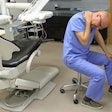
As dental professionals, we're no strangers to the physical demands of our work. The long hours, challenging patients, repetitive motions, and often awkward postures lead to stress that takes a toll on our bodies and minds. Burnout is a growing concern in our profession, and it's not just about feeling tired -- it's the combination of physical, mental, and emotional exhaustion that can sap our passion for the work we love.
But what if we could take a more integrative approach to managing this stress? By combining practical ergonomic principles, therapeutic yoga designed for dental professionals, and mindfulness practices into our day, we can combat burnout and enhance our overall well-being.
Let's explore strategies to help us thrive in and out of the office.
Creating a healthier workspace
Ergonomics is about creating a work environment that supports our bodies, reduces strain, and prevents injury. When our workstations are set up with the practitioner's health in mind, we're less likely to experience the physical fatigue that can lead to burnout.
1. Posture optimization: The first step to protecting your body from burnout is to ensure your posture is on point. Your spine should be aligned, head aligned over shoulders, elbows close to the body, knees higher than hips, and feet flat on the floor. Whenever you notice yourself in poor positioning, return to a neutral posture. Invest in a quality saddle stool or chair that fits and supports your body, allowing you to maintain a neutral posture.
2. Workspace setup: How we arrange our workspace, tools, and equipment can significantly affect how our bodies feel at the end of the day. Set up your room so that it supports proper alignment for you. Position the chair, patient, instruments, tools, and equipment within easy reach to avoid repetitive strain and awkward movements.
3. Movement and breaks: One of the simplest ways to prevent burnout is to incorporate movement into your day. Take microbreaks between patients to stretch and move around. Standing up, walking, and stretching for a minute helps reduce muscle fatigue, improves circulation, and shortens recovery time after work. Practitioners can also explore alternating between sitting and standing throughout the day to reduce the strain of prolonged sitting.
Yoga therapy tailored for dental work
Yoga isn't just for the yoga studio -- it can be an integral part of the workday, helping to release tension, improve mobility, reduce stress, and promote balance. Here are some simple yet effective ways to incorporate yoga in the dental office:
1. Chairside stretches: Chairside stretches are a great way to keep your body healthy at work. While sitting in your chair, try seated cat-cow: alternate between arching your back as you inhale and rounding your spine as you exhale. Follow this with gentle neck stretches: Tilt your head to each side, forward, and backward, to stretch the muscles in your neck and alleviate stiffness. Alternate between different areas of the body, or focus on a specific problem area throughout the day.
2. Standing poses: Side bends are perfect for a quick reset during your day. Stand with your feet hip-width apart, engage your core, and lengthen your spine. Inhale and raise your left arm overhead and exhale to lean toward the right, stretching the left side of your body. Repeat on the other side. This pose promotes posture and helps to reset after hours of leaning over patients. Another is a forward fold: From a standing position, hinge at the hips and fold forward, bending your knees and allowing your head and arms to hang. This pose relieves tension in your back and helps calm the mind.
3. End-of-day relaxation: After a long day, unwind with your legs placed up against a wall. Lie on the floor with your legs extended up against a wall. This pose promotes relaxation, reduces leg fatigue, improves circulation, and eases tension in the back.
Cultivating mindful moments in a busy dental practice
Mindfulness is about being present in the moment. It can be a powerful tool for reducing stress and preventing burnout throughout the workday. Integrating mindfulness into your day can cultivate a sense of calm and focus, even during the busiest days.
1. Breathing techniques: Diaphragmatic breathing is a simple yet powerful way to reduce stress. Practice deep breathing by inhaling and exhaling slowly through your nose, focusing on expanding your abdomen, ribs, and chest. You could also try box breathing -- inhaling for a count of four, holding for four, exhaling for four, and holding for four. These techniques help calm the mind and regulate the nervous system.
2. Mindful moments: Incorporating small moments of mindfulness throughout your day can make a big difference. A body scan meditation, where you mentally scan your body from head to toe, noting areas of tension and consciously relaxing them, can be done in a minute and offers immediate stress relief between patients.
3. Integrating mindfulness into daily routine: Even routine tasks can become moments of mindfulness. Slow down and become present when washing your hands, cleaning your room, or seating a patient. Incorporating mindfulness helps to prevent stress from accumulating throughout the day.
Integrating ergonomic adjustments, yoga, and mindfulness into your daily routine can effectively combat burnout and enhance overall well-being. These strategies alleviate physical strain and promote mental and emotional resilience, leading to a healthier, more fulfilling career in dentistry. Remember, small changes can make a big difference. Start incorporating these practices today, and notice how they can transform your workday and beyond.
Editor's note: References available upon request.
Caitlin Parsons, RDH, is a practicing dental hygienist, yoga therapist, ergonomics expert, and the founder of The Aligned Hygienist. She is a writer, public speaker, consultant, podcast host, and content creator. Caitlin specializes in ergonomics, yoga therapy, pain prevention, stress management, and burnout for dental professionals, teams, and organizations, and can be reached at [email protected].
The comments and observations expressed herein do not necessarily reflect the opinions of DrBicuspid.com, nor should they be construed as an endorsement or admonishment of any particular idea, vendor, or organization.



















